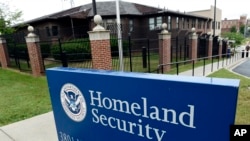The Trump administration announced new rules Friday to scrutinize petitions to bring in underage spouses to the U.S., after data showed thousands of requests by men to bring in child and adolescent brides had been approved.
U.S. Citizenship and Immigration Services said it was updating guidance to adjudicators that stresses marriages involving minors warrant special attention. They must ensure the marriage was lawful where it was celebrated, and is legal in the state where they will live, and that it is bona fide and the minor consented freely to it.
The Associated Press last month obtained data showing there were more than 5,000 cases of adults petitioning on behalf of minors and nearly 3,000 examples of minors seeking to bring in older spouses or fiancees.
The approval of the petitions is the first of a two-step visa process, and USCIS had already said it has taken steps to better flag and vet the petitions.
They are legal. The Immigration and Nationality Act does not set minimum age requirements for the person making the request or for that person's spouse or fiancee. By contrast, to bring in a parent from overseas, a petitioner has to be at least 21 years old.
And in weighing petitions, U.S. Citizenship and Immigration Services goes by whether the marriage is legal in the spouse's or fiancee's home country and then whether the marriage would be legal in the state where the petitioner lives.
Forced marriage?
Marriage between adults and minors is not uncommon in the U.S., and most states allow children to marry with some restrictions.
But the data raise questions about whether the immigration system may be enabling forced marriage and about how U.S. laws may be compounding the problem despite efforts to limit child and forced marriage.
The USCIS changes will not stop child marriage — age limits must be set by Congress, and states — but officials hope it will help detect instances where a spouse is in the marriage against her will.
"USCIS is taking action to the maximum extent permitted under current immigration law to highlight special considerations in the adjudication of marriage-based immigrant petitions involving a minor," said USCIS Director L. Francis Cissna. "While these are steps in the right direction, ultimately it is up to Congress to bring more certainty and legal clarity to this process for both petitioners and USCIS officers."
There is a two-step process for obtaining U.S. immigration visas and green cards. Petitions are first considered by USCIS. If granted, they must be approved by the State Department. Overall, there were 3.5 million petitions received from budget years 2007 through 2017.
'Incentivizing child marriage'
Over that period, there were 5,556 approvals for those seeking to bring minor spouses or fiancees, and 2,926 approvals by minors seeking to bring in older spouses, according to the data. Additionally, there were 204 for minors by minors. Petitions can be filed by U.S. citizens or permanent residents. In nearly all the cases, the girls were the younger person in relationship.
USCIS didn't know how many of the approvals were granted by the State Department, but overall only about 2.6 percent of spousal or fiancee claims are rejected. There are no nationwide statistics on child marriage, but data from a few states suggest it is far from rare. State laws generally set 18 as the minimum age for marriage, yet every state allows exceptions. Most states let 16- and 17-year-olds marry if they have parental consent, and several states — including New York, Virginia and Maryland — allow children under 16 to marry with court permission.
Fraidy Reiss, who campaigns against coerced marriage as head of a group called Unchained at Last, said there must be a change in the law.
"What we need is strong legislation that closes the dangerous immigration loophole that currently allows children of any age to petition for a foreign spouse or fiance(e) or to be the beneficiary of a spousal or fiance(e) visa," she said. "We need to stop incentivizing child marriage."




